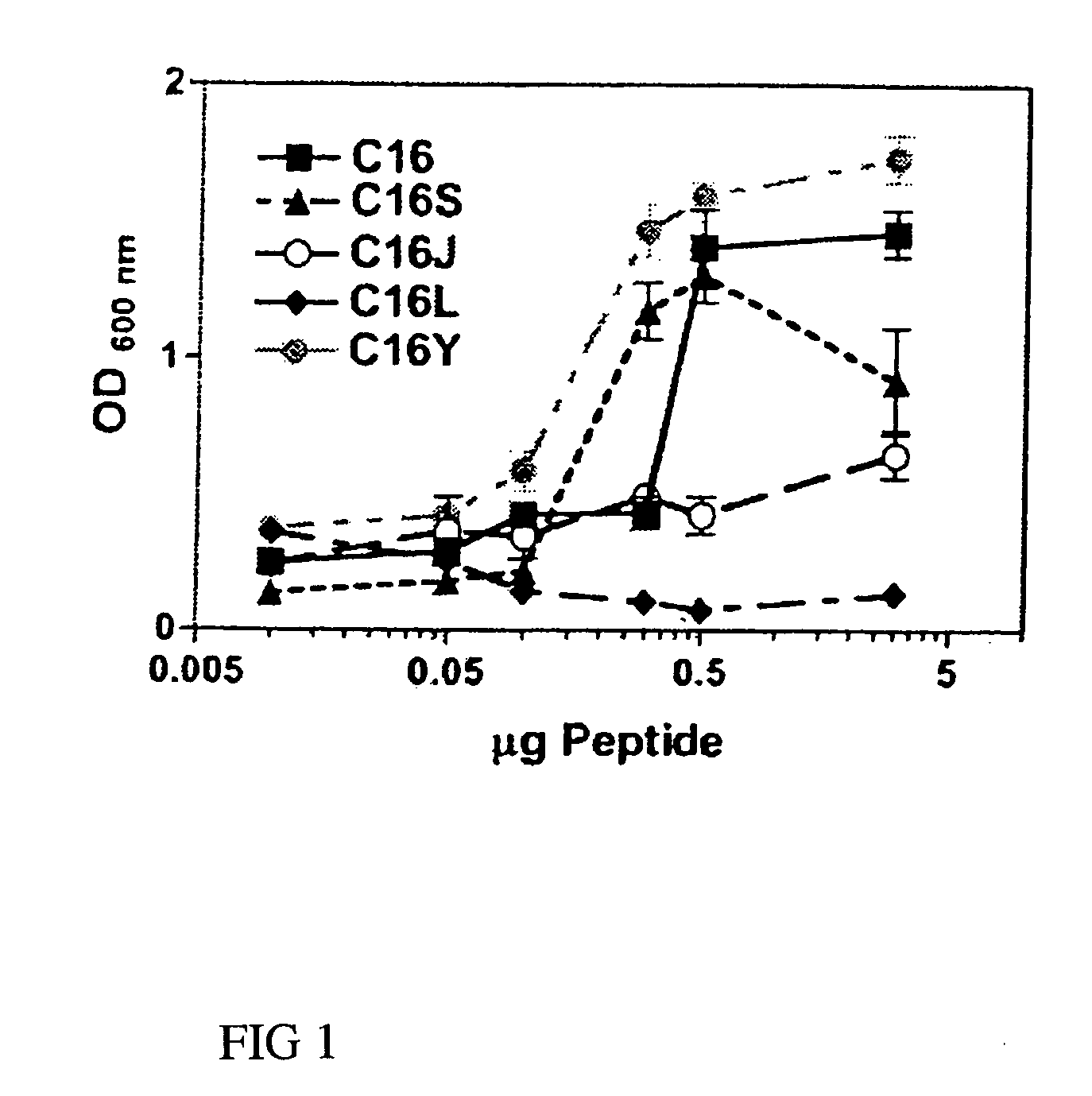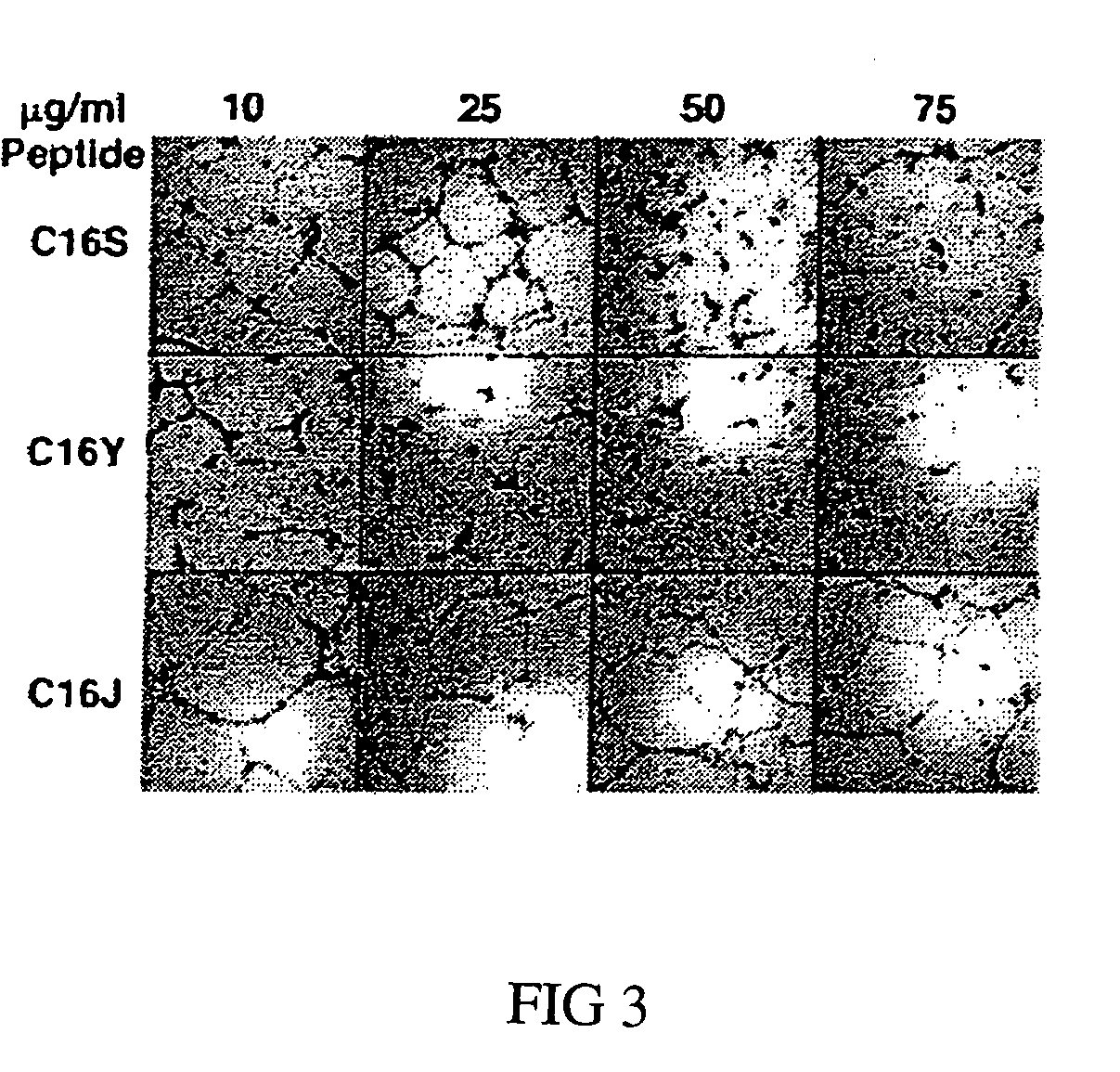Therapeutic Administration Of The Scrambled Anti-Angiogenic Peptide C16Y
a technology of anti-angiogenic peptides and scrambled proteins, which is applied in the field of ocular disease, can solve problems such as vision loss
- Summary
- Abstract
- Description
- Claims
- Application Information
AI Technical Summary
Benefits of technology
Problems solved by technology
Method used
Image
Examples
example 1
Endothelial Cell Adhesion by C16 and Scrambled C16 Peptides
[0055]Endothelial cell adhesion assays were performed on 96-well plates coated overnight with either laminin-1 (0.5 μg) or synthetic laminin peptides C16, C16S, C16J, C16L, or C16Y (0-5 μg) as described previously (Malinda 1999). Wells were rinsed with PBS, blocked with 2 mg / ml of BSA, and rinsed again with PBS. Cell adhesion was performed using 0.1 ml of RPMI 1640 containing 35,000 HUVECs. After a 1.5-hour incubation period at 37° C., unbound cells were decanted and attached cells were fixed and stained with 20% methanol / 0.2% crystal violet. Dishes were extensively rinsed, and bound dye was solubilized in 2% SDS and quantitated at 600 nm. Assays were done in triplicate at least three times.
[0056]Cells attached to C16, the parent peptide, and to C16S at amounts >0.1 μg (FIG. 1). Although C16Y showed a similar attachment pattern to that of C16 and C16S, more cells adhered to it than to any other peptide at all of the amounts ...
example 2
Ability of C16 and Scrambled C16 Peptides to Block Laminin-1 Endothelial Cell Adhesion
[0057]Competition experiments were done using 96-well plates coated with laminin-1 (0.5 μg) in the presence of 0-100 μg / ml of competing C16, C16S, C16J, C16L, or C16Y synthetic laminin peptide as specified. Control wells were coated with BSA only. Wells were contacted with 0.1 ml of RPMI 1640 containing 35,000 HUVECs. After a 1.5-hour incubation at 37° C., unbound cells were decanted and attached cells were fixed and stained with 20% methanol / 0.2% crystal violet. Dishes were extensively rinsed, and bound dye was solubilized in 2% SDS and quantitated at 600 nm. Assays were done in triplicate at least three times.
[0058]C16Y had the strongest inhibitory activity at all concentrations tested (FIG. 2). The most significant differences were observed at 50 μg / ml, where C16Y inhibited endothelial cell attachment to laminin-1 by >70%. C16 and C16S, on the other hand, inhibited by 75 μg / ml.
example 3
Disruption of Endothelial Cell Tube Formation by C16Y
[0059]Tube-forming assays were performed as described previously (Ponce 2001). 48-well plates were coated with 200 μl / well of Matrigel (Gho 2001; Kubota 1988), a basement membrane matrix. HUVECs (24,000 cells / well) were plated in RPMI 1640 containing 10% bovine calf serum, defined and supplemented (HyClone Laboratories, Inc., Logan, Utah), along with 100 mg / liter of endothelial cell growth factor (Collaborative Biomedical). C16 or scrambled C16 peptides were added at concentrations ranging from 10-75 μg / ml. Control wells contained medium only. After 16 hours, cells were fixed and stained with Diff-Quick fixative (methanol) and solution II (6.25% (w / v) each of azure A and methylene blue) (Dade A G, Dudingen, Switzerland), and tube formation was scored by a blinded observer. Each peptide was tested at least in triplicate, and the assays were repeated a minimum of three times.
[0060]As expected, C16 and C16S disrupted tube formation a...
PUM
| Property | Measurement | Unit |
|---|---|---|
| Composition | aaaaa | aaaaa |
Abstract
Description
Claims
Application Information
 Login to View More
Login to View More - R&D
- Intellectual Property
- Life Sciences
- Materials
- Tech Scout
- Unparalleled Data Quality
- Higher Quality Content
- 60% Fewer Hallucinations
Browse by: Latest US Patents, China's latest patents, Technical Efficacy Thesaurus, Application Domain, Technology Topic, Popular Technical Reports.
© 2025 PatSnap. All rights reserved.Legal|Privacy policy|Modern Slavery Act Transparency Statement|Sitemap|About US| Contact US: help@patsnap.com



